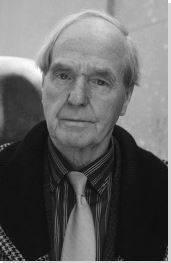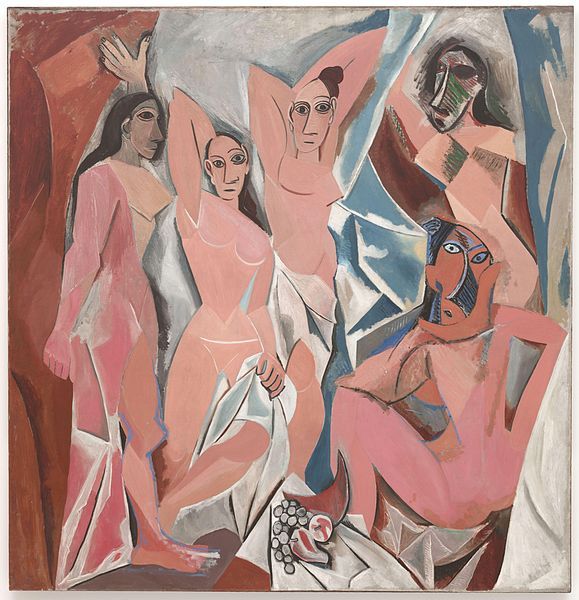Summary of Henry Moore
Henry Moore was probably the quintessential British sculptor of the 20th century. Non-Western art was crucial in shaping his early work, leading European modernists were later influences, and Moore united these inspirations was a deeply felt humanism. He returned again and again to the motifs of the mother and child, and the reclining figure, and often used abstract forms to draw analogies between the human body and the landscape. Although sculpture remained his principal medium, he was also a fine draughtsman, and his images of figures sheltering on the platforms of subway stations in London during the bombing raids of World War II remain much loved. His interest in the landscape, and in nature, has encouraged the perception that he has deep roots in traditions of British art, yet his softly optimistic, redemptive view of humanity also brought him an international audience. Today, few major cities are without one of his reclining figures, reminders that the humanity can rebound from any disaster.
Accomplishments
- The foundation of Moore's approach was direct carving, something he derived not only from European modernism, but also from non-Western art. He abandoned the process of modeling (often in clay or plaster) and casting (often in bronze) that had been the basis of his art education, and instead worked on materials directly. He liked the fierce involvement direct carving brought with materials such as wood and stone. It was important, he said, that the sculptor "gets the solid shape, as it were, inside his head... he identifies himself with its center of gravity."
- Related to his commitment to direct carving was a belief in the ethic of 'truth to materials.' This was the idea that the sculptor should respect the intrinsic properties of media like wood and stone, letting them show through in the finished piece. A material had its own vitality, Moore believed, "an intense life of its own," and it was his job to reveal it.
- During the 1930s, Moore's most fruitful and experimental decade, he was influenced by both Constructivism and, to a much greater extent, Surrealism. From the former he came to appreciate the importance of abstract form, from the latter he derived much of his interest in lending a human and psychological dimension to his sculpture. But Surrealism also shaped his mature style. It encouraged his love of biomorphic forms, and also suggested how the human figure could be fragmented into parts and reduced to essentials.
- Moore's interest in non-Western art gave much of his early work a frontal character, yet as he matured he became more interested in utilizing three dimensions. It was this which led him to introduce 'holes' into his sculptures, so that the object almost seems to grow out of an absent center.
- Just as the human body inspired Moore's forms, so too did the natural world. He often derived ideas from objects such as pebbles, shells and bones, and the way he evoked them in his sculpture encouraged the viewer to look upon the natural world as one endlessly varied sculpture, created continually by natural processes. Evoking both the natural world and the human body simultaneously in his work, Moore created a picture of humanity as a powerful natural force.
The Life of Henry Moore
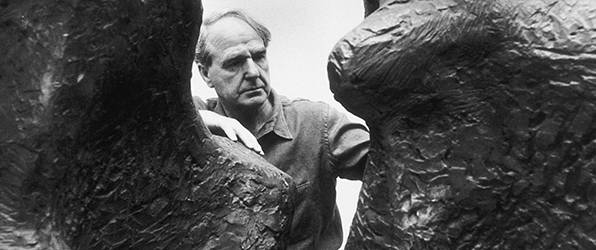
Moore was driven to create works that defined opened spaces - he said: "Sculpture is an art of the open air... I would rather have a piece of my sculpture put in a landscape, almost any landscape, than in, or on, the most beautiful building I know."
Important Art by Henry Moore
Reclining Figure
This was the first figure Moore sculpted in brown Hornton stone, and it was heavily influenced by an Aztec sculpture, the Chacmool figure, of which he saw a cast in a Paris museum. Moore said of the Chacmool figure that it was the most important work to influence his early career: "Its stillness and alertness, a sense of readiness - and the whole presence of it, and the legs coming down like columns." Moore's own Reclining Figure is emblematic of the influence of non-Western art on his earliest work, something that came to him in part though Roger Fry's book Vision and Design. The figure is also one of the earliest instances of Moore's use of the reclining figure, a motif that would be central to his mature style.
Brown Hornton Stone - Leeds City Art Gallery
Four-Piece Composition: Reclining Figure
Four-Piece Composition illustrates the enormous impact that Surrealism had on Moore in the early 1930s - displacing his earlier interest in non-Western art. Inspiration for the piece may have come from Alberto Giacometti's Woman with Her Throat Cut (1932), since this would have provided Moore with the idea of fragmenting the figure, and dispersing it horizontally across its base (rather than making it stand erect, like a traditional monumental sculpture). Moore's piece is incised with fine diagrammatic lines, a technique common in his work in the 1930s. He may have derived this idea from Joan Miró, though it may also have come from the work of the British Constructivist Ben Nicholson, who was a friend of Moore. In this respect Four-Piece Composition demonstrates how Moore combined such seemingly opposed currents as Constructivism and Surrealism.
Cumberland Alabaster - Collection of the Tate, United Kingdom
Bird Basket
It has been suggested that the influence for this piece may have come from non-Western art, in particular from friction drums made on the Oceanic island of New Ireland. However, it also demonstrates the way Moore combined aspects of Surrealism and Constructivism in the 1930s, since the biomorphic form of the sculptures clearly derives from the former, while the geometry of the strings might derive from the latter. The piece also points to Moore's interest in open and closed forms: he was intrigued by the way it was possible to perceive continuities between the mass of an object and the space around it - the way, perhaps, the space around the Bird Basket grips it, rather than the other way around. The strings serve to emphasize the space around the figure, even though our eye can still see through them to the hard mass of the sculpture's body.
Lignum vitae and string - Henry Moore Foundation
Helmet
This is the first of Moore's sculptures to feature the idea of internal and external forms. Not until the end of the 1940s did he return to the idea, but it became important to him, providing another means to pose the contrast between hard and soft that his sculptures often suggest. This piece may have been inspired by an illustration of ancient Greek tools, though Moore has said it may equally have come from his interest in armor, or from a remark made by the artist and writer Wyndham Lewis, about cutting into a lobster and finding it soft inside its hard shell.
Bronze - Henry Moore Foundation
Tube Shelter Perspective
At the outset of WWII, Moore was approached to be an official War Artist, but he declined, feeling that his style wasn't suitable to the work. However, one evening during the war, when he and his wife were returning from dinner with friends, they were forced to take shelter on the platform of Belsize Park tube station during a heavy air raid, and he was astonished at what he witnessed. "It was like a huge city in the bowels of the earth. When I first saw it...I saw hundreds of Henry Moore figures stretched along the platform." He drew the figures from memory on return to his studio, and went on to complete 3 sketchbooks full of drawings. The War Artists Committee later purchased a number of larger drawings from Moore, including Tube Shelter Perspective, and distributed them to galleries around England to help boost morale.
Pencil, ink, wax and watercolor on paper - Collection of the Tate, United Kingdom
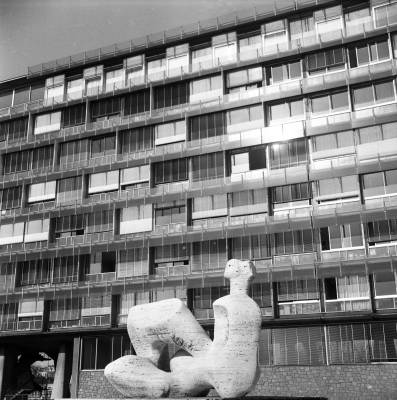
Reclining Figure
The commission to produce a sculpture for the headquarters of UNESCO, in Paris, was Moore's first major international commission for public art. In later years he would become synonymous with such projects. It also occasioned his largest sculpture to date, a figure stretching over 16 feet in length. Originally commissioned by UNESCO to create a bronze sculpture, Moore felt the dark material would have rendered the piece ineffective against the building's glass background. Instead, he used travertine marble, the same material as the building's roof. This sculpture is a testament to his adaptability, with the finished sculpture weighing 39 tons and composed of four separate blocks of material. It has been described as a latter day Athena, the Greek goddess of wisdom.
Travertine marble - UNESCO Headquarters, Paris
Biography of Henry Moore
Childhood
Henry Moore was born in Castleford in Yorkshire, on July 30, 1898. The seventh of eight children of a mining engineer and homemaker, Moore was encouraged by his often financially struggling father to pursue higher education and a white collar career. And his father's strong opposition to the harsh physical lifestyle of mining created conflict when Moore later chose sculpting as his vocation, a job his father regarded as manual labor. Inspired by Michelangelo, Moore began modeling in clay and wood at his school in Castleford, where several of his siblings had attended and to which he had been granted a scholarship.
Early Training
In 1919, after a brief period of teaching, and serving in the Civil Service Rifles regiment during World War I, Moore was awarded an ex-serviceman's grant with which he enrolled at Leeds School of Art, becoming their first sculpture student. There he met and was strongly influenced by Barbara Hepworth. Moore received a scholarship two years later to pursue studies at the Royal College of Art in London. While there he spent much time at the British Museum studying their ethnographic collections, which strongly informed his later monumental figurative works. In 1924 he toured Italy and France for six months where he was impressed by the art of Giotto, Masaccio and Michelangelo. Upon his return to Paris, he enrolled in classes that periodically met at the Louvre. And it was in Paris, at the Musée d'Ethnographie, that he encountered a plaster cast of the Chacmool, an Aztec sculpture from c.900-1000 AD that would be a crucial influence on his early work (the original sculpture is in the collection of the Museo Nacional de Antropologia, Mexico City). The Chacmool encouraged his inclination to create direct carved, single figures focused on their mass and form.
Mature Period
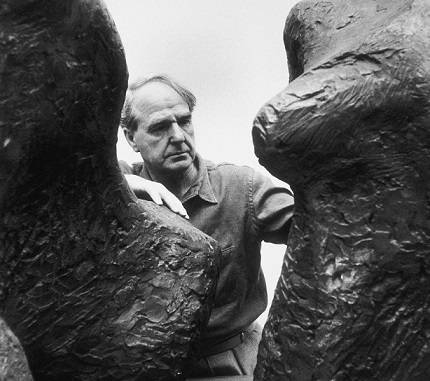
After his schooling, Moore accepted a seven year teaching position at the Royal College of Art in London. In 1928, he quickly received his first public commission, West Wind, from the London Underground. During this time he also married Kyiv-born painting student Irina Radestsky, and they joined a group of enclave of artists, architects and writers - including Barbara Hepworth, Ben Nicholson, Naum Gabo and Piet Mondrian - living in north London.
Moore became Head of the Department of Sculpture at the Chelsea School of Art in 1932. During this time he joined forces with Hepworth, her partner Ben Nicholson, and several other abstract modernists, to dominate the Seven and Five Society. Together they regularly visited Paris to see work by Picasso, Braque and Giacometti. Moore abandoned a brief interest in Surrealism in 1936 after his role as an organizer of the "London International Surrealist Exhibition" and returned to his modernist figurative work in 1937 with a career-changing sale of Mother and Child to a private collector whose public display of the monumental work created two years of protest and controversy in his conservative Hempstead community.
Moore was forced to resign his teaching post and accept a commission as a war artist at the onset of World War II. During this time he made a series of drawings of Londoners sheltering from bombing raids on the platforms of subway stations. He spoke of being struck by the sight of the figures - so like his own sculptures - stretched along the platforms, and rendered them almost as cocoons, or hibernating animals. In 1940, Moore's own home was bombed, so they moved to a farm house in Perry Green where he lived and worked for the rest of his prolific career.
Late Period
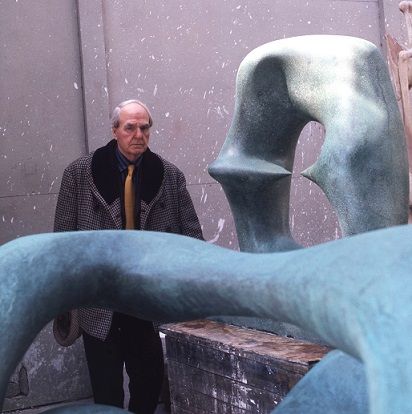
In 1946, Moore traveled to America for the first time to view his retrospective at the Museum of Modern Art in New York. At the same time, with the birth of his daughter, Mary, and the death of his mother, his usually single-figure work transformed to reflect his new family structure, and he began to be interested in the mother and child motif. Yet his work also became more abstract. He became interested in the idea of puncturing the previously integral form of his sculptures with holes, and playing on the contrast of positive versus negative space. In 1950, he completed a multi-figured sculpture called Family Group, his first large-scale public bronze, commissioned by a secondary school in Stevenage. During the 1950s, Moore's public works were in steady demand. Prices for his pieces increased significantly and his profile as an international artist was heightened. With increasingly larger and more complicated commissions, including UNESCO's Reclining Figure, Moore added apprentices and assistants to his workshop, a move that while practical, drew criticism from some art world purists.
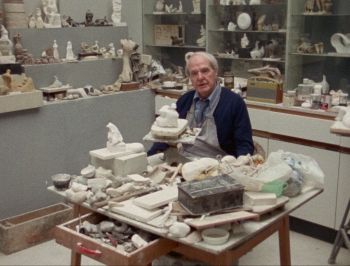
By the 1970s, Moore's work was included in over 40 shows a year and he was one of the most financially successful living artists in the world. At the end of that decade, the Henry Moore Foundation, which now manages his home as a gallery and museum, was founded to promote the preservation and publicity of his public works. Many honors were bestowed upon him, including receiving knighthood in 1951 (which he turned down), the Companion of Honor in 1955, the Order of Merit in 1963; and later gained positions as a Trustee at both the National Gallery and the Tate.
The Legacy of Henry Moore
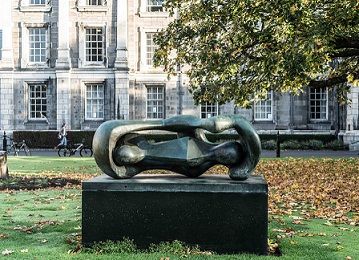
During his lifetime, Moore became synonymous with modern sculpture in England, America and beyond, introducing a wide public to modern styles such as Surrealism and primitivism. Indeed he is almost synonymous with the many worldwide institutions outside which his grandest public sculptures stand, encapsulating their humanitarian mission. His reputation has declined since his death, a consequence in part of the prolific production of his later years, and in part due to a distaste for his soft, sometimes cloying humanism. Yet he undoubtedly had a great impact on the generation that followed him, inspiring figures as diverse as Eduardo Paolozzi, William Turnbull, and - because they were at one time assistants in his studio - Anthony Caro and Phillip King.
Influences and Connections

-
![Michelangelo]() Michelangelo
Michelangelo -
![Pablo Picasso]() Pablo Picasso
Pablo Picasso -
![Jacob Epstein]() Jacob Epstein
Jacob Epstein ![Henri Gaudier-Brzeska]() Henri Gaudier-Brzeska
Henri Gaudier-Brzeska
-
![Barbara Hepworth]() Barbara Hepworth
Barbara Hepworth -
![Ben Nicholson]() Ben Nicholson
Ben Nicholson ![Herbert Read]() Herbert Read
Herbert Read![Roland Penrose]() Roland Penrose
Roland Penrose
-
![Anthony Caro]() Anthony Caro
Anthony Caro ![William Turnbull]() William Turnbull
William Turnbull![Phillip King]() Phillip King
Phillip King
-
![Barbara Hepworth]() Barbara Hepworth
Barbara Hepworth -
![Ben Nicholson]() Ben Nicholson
Ben Nicholson ![Herbert Read]() Herbert Read
Herbert Read
-
![Surrealism]() Surrealism
Surrealism ![Public Sculpture]() Public Sculpture
Public Sculpture
Useful Resources on Henry Moore
- Henry Moore: My Ideas, Inspiration And Life As An Artist
- Henry Moore: Writings and Conversations (Documents of Twentieth-Century Art)Our Pick
- Henry Moore: Ideas for Sculpture
- Celebrating Moore: Works from the Collection of the Henry Moore FoundationBy David Mitchinson
- Henry Moore: Sculpting the Twentieth CenturyOur PickBy Dorothy Kosinski
- Henry Moore: 1898-1986 (Basic Art)By Jeremy Lewison
- Henry Moore: From the Inside Out: Plasters, Carvings, DrawingsBy Claude Allemand-Cosneau, Manfred Fath, David Mitchinson
- The Drawings of Henry MooreBy Andrew Causey
